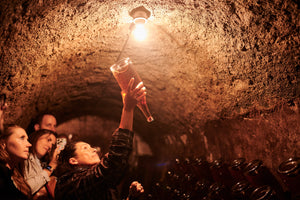If you’ve ever popped a bottle of bubbly, you’ve enjoyed a beverage that was crafted with the utmost care and attention. That is all thanks to the hard work of the chef de cave—the cellar master of Champagne production. Let’s take an inside look at how much this individual shoulders in the production of the bubbles we love so much.
A chef de cave is responsible for overseeing every aspect of Champagne production from grapes through fermentation and aging. They are essentially the brain of the cellar, as well as gatekeepers for quality control. This means that they are responsible for ensuring that only perfectly-ripened, high-quality grapes are harvested in the fields and taken to the press. They must also be intimately familiar with nature’s whims, since weather plays a crucial part in grape maturing time each year. Then, as they closely monitor the juice quality, they make decisions on what temperatures and vessels (wood, stainless steal or concrete) for primary fermentation.
Once all the initial decisions have been made and primary fermentation is complete, the crucial job of directing assemblage is the chef's next task. This is the phase where the chef de cave blends the still vin clair (reserve wines and current vintage wines) to create a harmonious and consistent flavor profile to best represent the champagne house through their numerous cuvées. These blends are bottles with the liquor de tirage and left to age as long as the chef de cave sees fit. But the work doesn't end there. They are regularly testing the aging champagnes to decide when each cuvée is ready to be disgorged. When that time comes, it is again up to the chef to decide the dosage level that will be added to each wine to create balance.
In addition to the actual champagne elaboration, they must also stay constantly connected with the global Champagne market to ensure that their product meets all standards required by national and international regulations. And finally, they have to keep up with trends in order to identify what consumers—both existing and potential—are looking for in terms of flavor combinations and styles. As one cycle is drawing to a close, another harvest will soon be on its way, meaning there is no rest for this vital role in Champagne production!
As you can see, there are many important roles that go into producing a bottle of Champagne—and none more important than that of a chef de cave! This highly-skilled individual shoulders heavy responsibilities throughout every step of production from harvesting all the way through blending and aging. The next time you pop open a bottle of bubbly, be sure to thank your favorite chef de cave! Their hard work and dedication make our sparkling wine experiences even more delightful!


